page. When the last B600 rolled off the production line in 1963, it was the last tube portable radio made in the U.S.
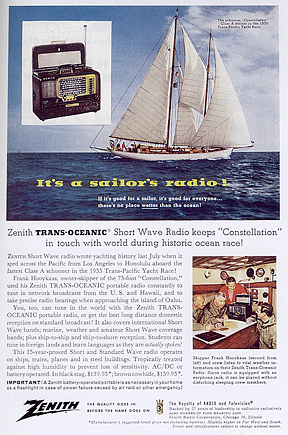 This particular B600 was the first Trans-Oceanic radio I acquired. It was offered to me when I was picking up a radio for someone else. I remembered these radios from my childhood and had always admired them, and was glad for the opportunity to acquire one. The radio was in very good condition, both cosmetically and electronically.
This particular B600 was the first Trans-Oceanic radio I acquired. It was offered to me when I was picking up a radio for someone else. I remembered these radios from my childhood and had always admired them, and was glad for the opportunity to acquire one. The radio was in very good condition, both cosmetically and electronically.
The only cosmetic defects were missing knob brights, and a crack in the upper right corner of the dial face, a common problem with these radios. The plastic front had no cracks, which is not always the case, unfortunately, with these radios. New knob brights are available from Antique Electronic Supply and can also be found on eBay.
When I bought the radio, the dial indicator would only move about 1/3 of the way across the dial. I could see that the dial string was intact, so I just worked the tuning dial gently back and forth until the dial would travel correctly, and accurately, across the dial. I removed the front panel to clean and lubricate the band switches. After a good cleaning, I gave this radio to my Dad for his 86th birthday. He used it for a while, then lost interest in it and it spent several years in storage. He passed away in 2013, and the radio is now back in my possession.
Since it was not playing as well as it did when I gave it to my Dad, I replaced the electrolytic capacitors. There are five electrolytic capacitors in the 600 series radios, a 60uF, 40uF, 20uF, and a 200uF, located in a multi-cap can that sits atop the chassis. The fifth electrolytic capacitor is buried in the chassis behind the tone control switches.
While it is possible to locate the new capacitors below the chassis, space is cramped and difficult to work in. It is much easier to re-stuff the old capacitor can. There is plenty of room in the can to hold all four capacitors, although in this case I choose to install the tiny 200uF cap under the chassis as its leads were a bit too short to reach down through the chassis to the proper terminal.
The only difference between the H500 and 600 series radios is that the multi-cap can is located on the front of the chassis, behind the dial face. To gain access to the can, first move the dial pointer to the far left of the dial, then remove the four scews that hold the dial face and backing plate to the tuning mechanism, then remove from the chassis. When re-installling the dial face, do not over-tight the screws or you may crack the plastic dial.
A hacksaw blade in a handle can be used to cut the can (see center photo below). It is a tight fit, but using short strokes, it takes about ten minutes to cut the can open. Once the new capacitors are installed, I just replace the cardboard cover over the base of the original can.
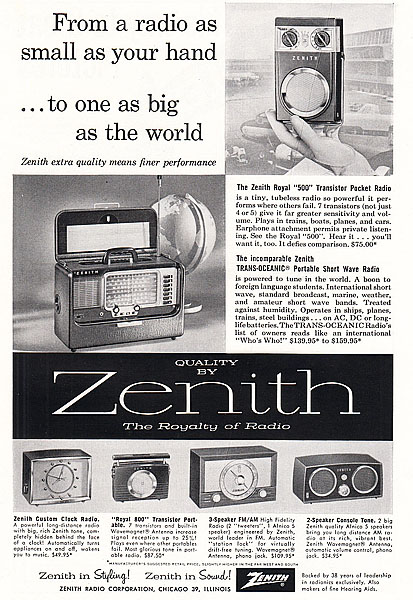
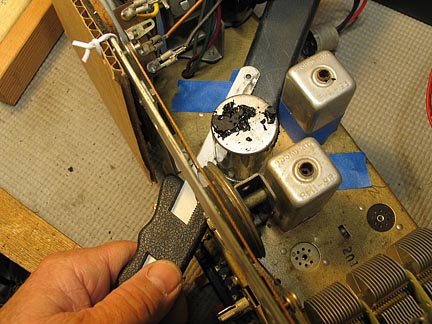
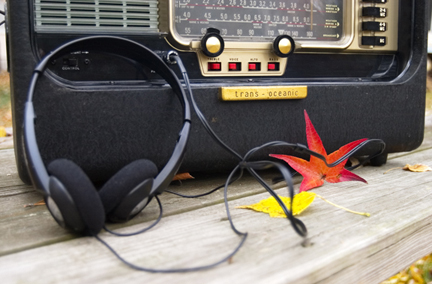
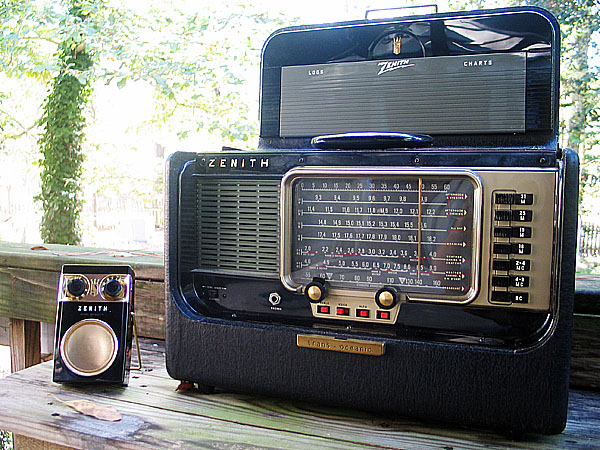
I checked the voltage at the selenium rectifier and it was good, so I left it alone, but I did install a safety capacitor across the AC line. I also decided to forego replacing the bumblebee capacitors for now, although one may eventually pop like a firecracker, and I'll then replace them all.
I was still having some problems with an occasionally dead radio on battery power. Checking voltages at the battery switch, I found the battery connector was not making good contact with the battery, so I disassembled it, replaced the 100 ohm resistor embedded inside, and then tightened the contacts. I also used super glue to repair the dial face as the crack had gotten larger. The radio is once again performing as it should.
At right, mirroring the Zenith ad at left, is the B600 alongside a 1958 Zenith 500RD pocket radio.



 This particular B600 was the first Trans-Oceanic radio I acquired. It was offered to me when I was picking up a radio for someone else. I remembered these radios from my childhood and had always admired them, and was glad for the opportunity to acquire one. The radio was in very good condition, both cosmetically and electronically.
This particular B600 was the first Trans-Oceanic radio I acquired. It was offered to me when I was picking up a radio for someone else. I remembered these radios from my childhood and had always admired them, and was glad for the opportunity to acquire one. The radio was in very good condition, both cosmetically and electronically.



